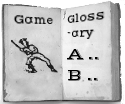Cat (Kat): Difference between revisions
No edit summary |
No edit summary |
||
| Line 6: | Line 6: | ||
|Invented Game=No | |Invented Game=No | ||
|Description=<p>per Culin. A batting game played with a six-inch, pointed wooden “cat.” The cat is pitched to a batter standing near a four-foot circle. The batter is out if he hits a caught fly or if the ball falls, unhit, into the circle. If put out, the batter goes to the end of the sequence of fielders, and the pitcher becomes the new batter. A batter can accrue points based on the distance from the circle to the where the hit ball lands. A version described by Newell[39] allows the batter to elevate and hit any cat that is pitched outside the circle.</p> | |Description=<p>per Culin. A batting game played with a six-inch, pointed wooden “cat.” The cat is pitched to a batter standing near a four-foot circle. The batter is out if he hits a caught fly or if the ball falls, unhit, into the circle. If put out, the batter goes to the end of the sequence of fielders, and the pitcher becomes the new batter. A batter can accrue points based on the distance from the circle to the where the hit ball lands. A version described by Newell[39] allows the batter to elevate and hit any cat that is pitched outside the circle.</p> | ||
<p><strong>Note: </strong>A Dutch book printed in 1845 also describes "Kat:" | <p><strong>Note: </strong>A Dutch book printed in 1845 also describes "Kat:" See http://protoball.org/1845.29.</p> | ||
<p>"The Kat is a piece of wood about 6 inches long, 1 1/2 to 2 inches wide at the midpoint and comes to a point at both ends making the form of a double cone. The Kat is placed on the ground in the middle of a big circle and a player uses a "ball stick" to hit one end of it to launch it into the air. As it comes down he tries to hit it out of the circle. If he fails to hit it or doesn't hit it out of the circle he steps off and the next player takes his turn. If he's successful he's assigned a certain number of points depending on how far he hit it." </p> | |||
<p> </p> | |||
<p> </p> | <p> </p> | ||
|Sources=<p><span>Stewart Culin, "Street Games of Boys in </span>Brooklyn, N.Y.<span>," </span><em>Journal of American Folklore</em><span> 4, no. 14 </span>(1891)<span>. page 233.</span></p> | |Sources=<p><span>Stewart Culin, "Street Games of Boys in </span>Brooklyn, N.Y.<span>," </span><em>Journal of American Folklore</em><span> 4, no. 14 </span>(1891)<span>. page 233.</span></p> | ||
|Has Supplemental Text=No | |Has Supplemental Text=No | ||
}} | }} | ||
Revision as of 12:05, 26 October 2016
| Game | Cat (Kat) |
|---|---|
| Game Family | Fungo |
| Location | |
| Regions | Europe, US |
| Eras | Predecessor, 1800s |
| Invented | No |
| Tags | |
| Description | per Culin. A batting game played with a six-inch, pointed wooden “cat.” The cat is pitched to a batter standing near a four-foot circle. The batter is out if he hits a caught fly or if the ball falls, unhit, into the circle. If put out, the batter goes to the end of the sequence of fielders, and the pitcher becomes the new batter. A batter can accrue points based on the distance from the circle to the where the hit ball lands. A version described by Newell[39] allows the batter to elevate and hit any cat that is pitched outside the circle. Note: A Dutch book printed in 1845 also describes "Kat:" See http://protoball.org/1845.29. "The Kat is a piece of wood about 6 inches long, 1 1/2 to 2 inches wide at the midpoint and comes to a point at both ends making the form of a double cone. The Kat is placed on the ground in the middle of a big circle and a player uses a "ball stick" to hit one end of it to launch it into the air. As it comes down he tries to hit it out of the circle. If he fails to hit it or doesn't hit it out of the circle he steps off and the next player takes his turn. If he's successful he's assigned a certain number of points depending on how far he hit it."
|
| Sources | Stewart Culin, "Street Games of Boys in Brooklyn, N.Y.," Journal of American Folklore 4, no. 14 (1891). page 233. |
| Source Image | [[Image:|left|thumb]] |
| Comment | Edit with form to add a comment |
| Query | Edit with form to add a query |
| Has Supplemental Text |
Comments
<comments voting="Plus" />
